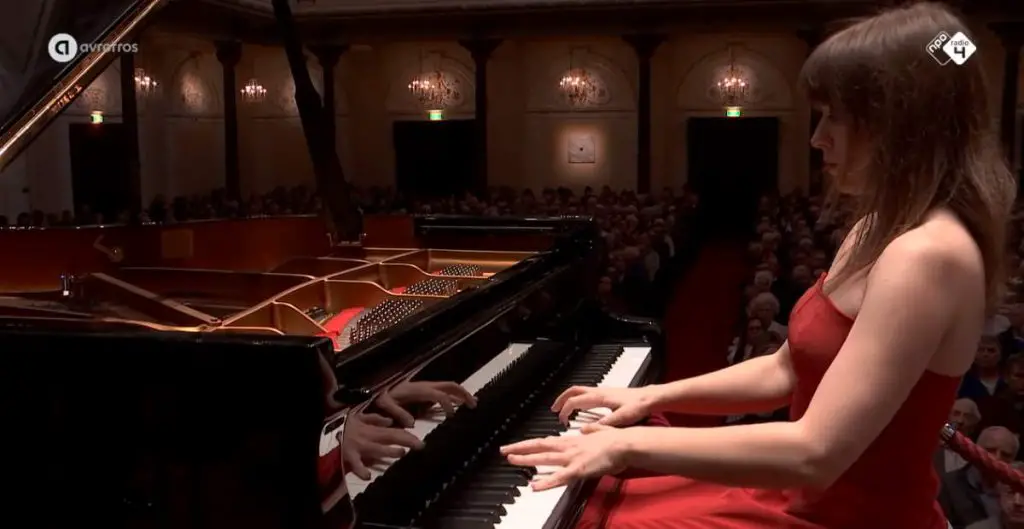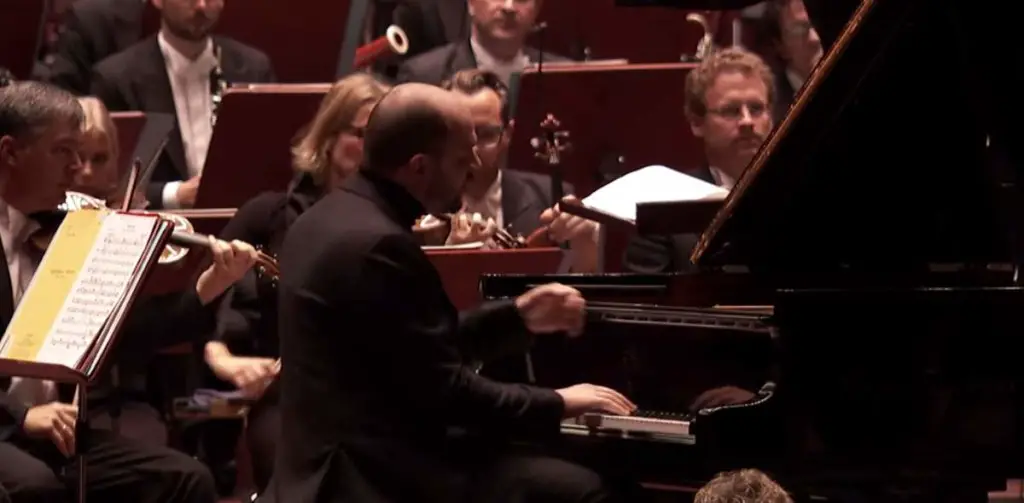Accompanied by the Orchestre Philharmonique du Luxembourg, Yuja Wang performs Sergei Rachmaninoff’s Rhapsody on a Theme of Paganini, Op. 43, a concertante work that was written for piano and orchestra, closely resembling a piano concerto, all in a single movement. Conductor: Gerard Oskamp. Conductor: Gustavo Gimeno. This performance was recorded at the Kinnekswiss Park in Luxembourg on July 1, 2023.
Sergei Rachmaninoff’s Rhapsody on a Theme of Paganini
Rachmaninoff’s Rhapsody on a Theme of Paganini, Op. 43, is one of his most celebrated compositions, written for solo piano and orchestra. Completed in 1934, it is a set of 24 variations on the 24th and last of Niccolò Paganini’s Caprices for solo violin, a piece known for its technical difficulty and inventive theme. Rachmaninoff’s work stands out not only for its virtuosic demands on the pianist but also for its ingenious orchestration and emotional depth.
The piece opens with an introduction followed by the theme, which is immediately recognizable and stated clearly by the orchestra. Each variation transforms the theme in imaginative ways, showcasing Rachmaninoff’s skill in blending complex piano technique with lush, dynamic orchestral textures.
One of the most famous sections is the 18th variation, a lyrical and romantic inversion of Paganini’s theme, often described as the emotional heart of the piece. This variation has become particularly popular and is frequently performed and recorded on its own.
Rachmaninoff weaves a variety of moods and styles throughout the Rhapsody, ranging from playful and witty to dark and brooding, reflecting his mastery of both the piano and the orchestral palette. The work also features elements of jazz and other contemporary influences, highlighting Rachmaninoff’s ability to incorporate modern styles into his classical framework.
The Rhapsody on a Theme of Paganini premiered in 1934 in Baltimore, Maryland, with Rachmaninoff himself as the soloist and Leopold Stokowski conducting the Philadelphia Orchestra. It was met with great acclaim and has since remained a staple of the piano repertoire, beloved by audiences for its combination of technical brilliance and emotional expressiveness.
Structure of the Rhapsody on a Theme of Paganini
Although Rachmaninoff’s work is performed in one stretch without breaks, the Rhapsody on a Theme of Paganini can be divided into three sections, as shown below. These correspond to the three movements of a concerto: up to variation 10 corresponds to the first movement, variations 11 to 18 are the equivalent of a slow movement, and the remaining variations make a finale.
ll variations are in A minor except where noted.
- Section 1:
- Introduction: Allegro vivace
- Variation 1: (Precedente)
- Theme: L’istesso tempo
- Variation 2: L’istesso tempo
- Variation 3: L’istesso tempo
- Variation 4: Più vivo
- Variation 5: Tempo precedente
- Variation 6: L’istesso tempo
- Variation 7: Meno mosso, a tempo moderato
- Variation 8: Tempo I
- Variation 9: L’istesso tempo
- Variation 10: L’istesso tempo
- Section 2:
- Variation 11: Moderato
- Variation 12: Tempo di minuetto (D minor)
- Variation 13: Allegro (D minor)
- Variation 14: L’istesso tempo (F major)
- Variation 15: Più vivo scherzando (F major)
- Variation 16: Allegretto (B♭ minor)
- Variation 17: (Allegretto) (B♭ minor)
- Variation 18: Andante cantabile (D♭ major)
- Section 3:
- Variation 19: A tempo vivace
- Variation 20: Un poco più vivo
- Variation 21: Un poco più vivo
- Variation 22: Marziale. Un poco più vivo (Alla breve)
- Variation 23: L’istesso tempo
- Variation 24: A tempo un poco meno mosso (A minor – A major)
Sources
- Rhapsody on a Theme of Paganini on Wikipedia
- Rhapsody on a Theme of Paganini, Op. 43 (Rachmaninoff, Sergei) on the International Music Score Library Project website

